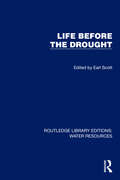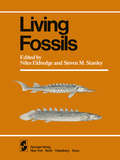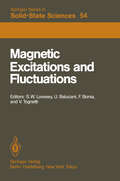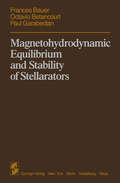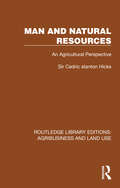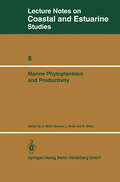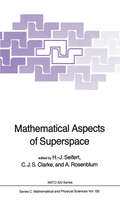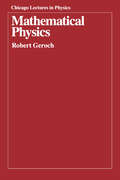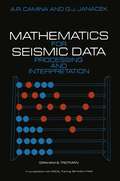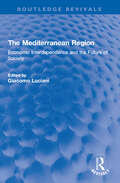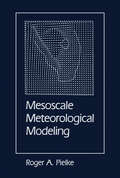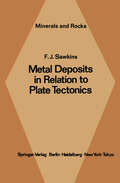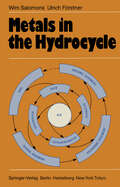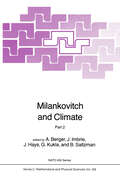- Table View
- List View
Life Before the Drought (Routledge Library Editions: Water Resources)
Little attention had been paid to the realities of life in the Savanna-Sahel of West Africa before the drought of 1968-74, but this book, originally published in 1984 provides a set of authoritative accounts of the way in which the inhabitants cope with what outsiders perceive as a harsh environment. The peoples of the Savanna-Sahel are shown to be developers of strategies and technologies to manage their resources. Their understanding of the environment enables them to contribute substantially to any plans for economic and ecological recovery in the region. Their cooperative modes of life lead to greater social complexity and capacity for survival. Geographers, anthropologists and social historians should find the interdisciplinary human ecological approach of the book appealing. Development economists and rural planners will find the chapters on land-use patterns, and resource use particularly valuable.
Living Fossils (Casebooks in Earth Sciences)
by Niles Eldredge and Steven M. StanleyThe case history approach has an impressive record of success in a variety of disciplines. Collections of case histories, casebooks, are now widely used in all sorts of specialties other than in their familiar appli cation to law and medicine. The case method had its formal beginning at Harvard in 1871 when Christopher Lagdell developed it as a means of teaching. It was so successful in teaching law that it was soon adopted in medical education, and the collection of cases provided the raw material for research on various diseases. Subsequently, the case history approach spread to such varied fields as business, psychology, management, and economics, and there are over 100 books in print that use this approach. The idea for a series of Casehooks in Earth Science grew from my experience in organizing and editing a collection of examples of one variety of sedimentary deposits. The prqject began as an effort to bring some order to a large number of descriptions of these deposits that were so varied in presentation and terminology that even specialists found them difficult to compare and analyze. Thus, from the beginning, it was evident that something more than a simple collection of papers was needed. Accordingly, the nearly fifty contributors worked together with George de Vries Klein and me to establish a standard format for presenting the case histories.
Magnetic Excitations and Fluctuations: Proceedings of an International Workshop, San Miniato, Italy, May 28 – June 1, 1984 (Springer Series in Solid-State Sciences #54)
by S. W. Lovesey U. Balucani F. Borsa V. TognettiMagnetohydrodynamic Equilibrium and Stability of Stellarators
by F. Bauer O. Betancourt P. GarabedianIn this book, we describe in detail a numerical method to study the equilibrium and stability of a plasma confined by a strong magnetic field in toroidal geometry without two-dimensional symmetry. The principal appli cation is to stellarators, which are currently of interest in thermonuclear fusion research. Our mathematical model is based on the partial differential equations of ideal magnetohydrodynamics. The main contribution is a computer code named BETA that is listed in the final chapter. This work is the natural continuation of an investigation that was presented in an early volume of the Springer Series in Computational Physics (cf. [3]). It has been supported over a period of years by the U.S. Department of Energy under Contract DE-AC02-76ER03077 with New York University. We would like to express our gratitude to Dr. Franz Herrnegger for the assistance he has given us with the preparation of the manuscript. We are especially indebted to Connie Engle for the high quality of the final typescript. New York F. BAUER October 1983 O. BETANCOURT P. GARABEDIAN Contents 1. Introduction 1 2. Synopsis of the Method 3 1. Variational principle 3 2. Coordinate system 6 3. Finite Difference Scheme 8 1. Difference equations ....................... " 8 2. Island structure ............................. 10 3. Accelerated iteration procedure .............. . . .. 12 Nonlinear Stability 15 4. 1. Second minimization . . . . . . . . . . . . . . . . .. . . 15 . . . . . 2. Test functions and convergence studies . . . . . . . .. . . 17 . 3. Comparison with exact solutions ................. 19 5. The Mercier Criterion 22 1. Local mode analysis . . . . . . . . . . . . . . . . .. . . 22 . . . . . 2. Computational method . . . . . . . . . . . . . . . .. . . 23 . . . .
Man and Natural Resources: An Agricultural Perspective (Routledge Library Editions: Agribusiness and Land Use #13)
by Cedric Stanton HicksOriginally published in 1975, yet prophetic in its wisdom this book deals with major aspects of man’s ecological destruction in an industrial framework. As well as discussing the destruction of forests by early civilizations the book examines the rate and extension of environmental deterioration in more recent times and the importance of the integrated ‘feed-back’ controls which maintain stability in the ecosphere of which humankind forms a part. Examining the role of entropy, energy quanta and indeterminacy in overthrowing both science and economic theory, the book provides examples from the 20th Century of the uncontrolled demands for energy and material resources, as well as of increasing toxic hazard in the biosphere.
Man and Natural Resources: An Agricultural Perspective (Routledge Library Editions: Agribusiness and Land Use #13)
by Cedric Stanton HicksOriginally published in 1975, yet prophetic in its wisdom this book deals with major aspects of man’s ecological destruction in an industrial framework. As well as discussing the destruction of forests by early civilizations the book examines the rate and extension of environmental deterioration in more recent times and the importance of the integrated ‘feed-back’ controls which maintain stability in the ecosphere of which humankind forms a part. Examining the role of entropy, energy quanta and indeterminacy in overthrowing both science and economic theory, the book provides examples from the 20th Century of the uncontrolled demands for energy and material resources, as well as of increasing toxic hazard in the biosphere.
Marine Phytoplankton and Productivity: Proceedings of the invited lectures to a symposium organized within the 5th conference of the European Society for Comparative Physiology and Biochemistry — Taormina, Sicily, Italy, September 5–8, 1983 (Coastal and Estuarine Studies #8)
by O. Holm-Hansen L. Bolis R. GillesWhen I was asked to organize this symposium on marine producti vity, it made me reflect on what aspects of this subject would be stimulating to a heterogeneous group of laboratory-oriented physiolo gists and biochemists. In recent years there have been several books which discusses the methodology commonly used in primary production studies and described the magnitude of photosynthetic CO reduction 2 in various areas of the world's oceans. I therefore decided to dis pense with these conventional aspects of primary production and invite researchers to speak on a variety of problems relating the abundance and activity of phytoplankton to environmental conditions. The lectures I invited were thus quite diverse in character, but all were related either to factors affecting the rate of photosynthesis or to the fate of reduced carbon as it passes through the microbial food web. In addition to these talks the participants benefited from a number of shorter presentations and poster sessions which dealt with production and cycling of organic carbon in the marine environment. February 1984 Osmund HOLM-HANSEN CONTENTS 1. Factors Governing Pelagic Production in Polar Oceans E. SAKSHAUG and O. HOLM-HANSEN •. ••. ••••. . . . . . •. •••. . ••••. •. •••• 1 2. Productivity of Antarctic Waters. A Reappraisal S. Z. EL-SAYED •. . . ••••••••. . •••. •. •••••••••. •••. •. •. . . . •. . . . •. 19 3. A Thermodynamic Description of Phytoplancton Growth D. A. KIEFER. . . . . . . . . . . . . . . . . . . . . . . . . . . . . . . . . . . . . . . . . . . . . . . . . . 35 4. Mechanisms of Organic Matter Utilization by Marine Bacterio plankton 45 F. AZAM and J. W.
Mathematical Aspects of Superspace (Nato Science Series C: #132)
by H. J. Seifert C. J. S. Clarke A. RosenblumOver the past five years, through a continually increasing wave of activity in the physics community, supergravity has come to be regarded as one of the most promising ways of unifying gravity with other particle interaction as a finite gauge theory to explain the spectrum of elementary particles. Concurrently im portant mathematical works on the arena of supergravity has taken place, starting with Kostant's theory of graded manifolds and continuing with Batchelor's work linking this with the superspace formalism. There remains, however, a gap between the mathematical and physical approaches expressed by such unanswered questions as, does there exist a superspace having all the properties that physicists require of it? Does it make sense to perform path integral in such a space? It is hoped that these proceedings will begin a dialogue between mathematicians and physicists on such questions as the plan of renormalisation in supergravity. The contributors to the proceedings consist both of mathe maticians and relativists who bring their experience in differen tial geometry, classical gravitation and algebra and also quantum field theorists specialized in supersymmetry and supergravity. One of the most important problems associated with super symmetry is its relationship to the elementary particle spectrum.
Mathematical Physics (Chicago Lectures in Physics)
by Robert GerochMathematical Physics is an introduction to such basic mathematical structures as groups, vector spaces, topological spaces, measure spaces, and Hilbert space. Geroch uses category theory to emphasize both the interrelationships among different structures and the unity of mathematics. Perhaps the most valuable feature of the book is the illuminating intuitive discussion of the "whys" of proofs and of axioms and definitions. This book, based on Geroch's University of Chicago course, will be especially helpful to those working in theoretical physics, including such areas as relativity, particle physics, and astrophysics.
Mathematical Physics (Chicago Lectures in Physics)
by Robert GerochMathematical Physics is an introduction to such basic mathematical structures as groups, vector spaces, topological spaces, measure spaces, and Hilbert space. Geroch uses category theory to emphasize both the interrelationships among different structures and the unity of mathematics. Perhaps the most valuable feature of the book is the illuminating intuitive discussion of the "whys" of proofs and of axioms and definitions. This book, based on Geroch's University of Chicago course, will be especially helpful to those working in theoretical physics, including such areas as relativity, particle physics, and astrophysics.
Mathematical Physics (Chicago Lectures in Physics)
by Robert GerochMathematical Physics is an introduction to such basic mathematical structures as groups, vector spaces, topological spaces, measure spaces, and Hilbert space. Geroch uses category theory to emphasize both the interrelationships among different structures and the unity of mathematics. Perhaps the most valuable feature of the book is the illuminating intuitive discussion of the "whys" of proofs and of axioms and definitions. This book, based on Geroch's University of Chicago course, will be especially helpful to those working in theoretical physics, including such areas as relativity, particle physics, and astrophysics.
Mathematical Physics (Chicago Lectures in Physics)
by Robert GerochMathematical Physics is an introduction to such basic mathematical structures as groups, vector spaces, topological spaces, measure spaces, and Hilbert space. Geroch uses category theory to emphasize both the interrelationships among different structures and the unity of mathematics. Perhaps the most valuable feature of the book is the illuminating intuitive discussion of the "whys" of proofs and of axioms and definitions. This book, based on Geroch's University of Chicago course, will be especially helpful to those working in theoretical physics, including such areas as relativity, particle physics, and astrophysics.
Mathematics for Seismic Data Processing and Interpretation
by A.R. Camina J. JanacekWith the growth of modern computing power it has become possible to apply far more mathematics to real problems. This has led to the difficulty that many people who have been working in various jobs suddenly find themselves not understanding the modern processing which is being applied to their own professional field. It also means that the people presently being trained in these subjects need to understand a much wider range of mathe matics than in the past. It is to both of these groups that this book is addressed. The major objective is to present the reader with the basic mathematical understanding to follow the new developments in their own field. The mathematics in this book is based on the need to understand signal process ing. The modern work in this area is mathematically very sophisticated and our purpose is not to train professional mathematicians but to make far more of the literature accessible. Since this book is based on courses devised for Racal Geophysics there is clearly going to be a bias towards the applications in that area, as the title implies. It is also true that the bibliogra phy has been chosen in order to aid the reader in that field by pointing them in the direction of recent applications in geophysics.
The Mediterranean Region: Economic Interdependence and the Future of Society (Routledge Revivals)
by Giacomo LucianiFirst published in 1984, The Mediterranean Region considers the broad economic and political problems facing the region from a variety of perspectives. The book features the work of international experts on the Mediterranean region. It discusses the changing legal environment and covers the Law of the Sea as applied to the Mediterranean, and the position of the Arab countries in the region. Chapters are also devoted to exploring the different policies of Russia, the United States, and Europe, towards the Mediterranean. The Mediterranean Region is a detailed contribution to research and understanding of the area.
The Mediterranean Region: Economic Interdependence and the Future of Society (Routledge Revivals)
by Giacomo LucianiFirst published in 1984, The Mediterranean Region considers the broad economic and political problems facing the region from a variety of perspectives. The book features the work of international experts on the Mediterranean region. It discusses the changing legal environment and covers the Law of the Sea as applied to the Mediterranean, and the position of the Arab countries in the region. Chapters are also devoted to exploring the different policies of Russia, the United States, and Europe, towards the Mediterranean. The Mediterranean Region is a detailed contribution to research and understanding of the area.
Mesoscale Meteorological Modeling
by Roger A. Pielke Sr.To effectively utilize mesoscale dynamical simulations of the atmosphere, it is necessary to have an understanding the basic physical and mathematical foundations of the models and to have an appreciation of how a particular atmospheric system works. Mesoscale Meteorological Modeling provides such an overview of mesoscale numerical modeling. Starting with fundamental concepts, this text can be used to evaluate the scientific basis of any simulation model that has been or will be developed. Basic material is provided for the beginner as well as more in-depth treatment for the specialist. This text is useful to both the practitioner and the researcher of the mesoscale phenomena.
Metal Deposits in Relation to Plate Tectonics (Minerals, Rocks and Mountains #17)
by F. J. SawkinsI attempt this volume with no small degree of trepidation, for despite the near universal acceptance of plate tectonic theory, and the undeniable sweep and power of the concepts in volved, points of controversy and uncertainty still abound. This is especially true with regard to the limited extent to which many ancient geologic terrains, however well studied, lend themselves to plate tectonic interpretation. There is also considerable controversy regarding the genesis of many metal deposits, and this impacts upon the degree to which such deposits can be meaningfully related to the tectonic settings in which they occur. It is relatively simple matter to point out that certain types of ore deposits exhibit impressive time-space associations with certain kinds of more recent plate boundary environ ments. It is also all too easy to possible plate tectonic-ore deposit relationships in ancient geologic terrains. What is more challenging is the recognition of the boundaries beyond which speculation is idle, but within which useful new insights regarding the relationship of certain ores to their lithologic and tectonic environments may emerge.
Milankovitch and Climate: Understanding the Response to Astronomical Forcing (NATO ASI Series #126)
by A. BergerMineral Processing in Developing Countries: A Discussion of Economic, Technical and Structural Factors
by United NationsThe Morphostructure of the Atlantic Ocean Floor: Its Development in the Meso-Cenozoic (International Astronomical Union Transactions #19A)
by V.M. LitvinThe study of the topography and structure of the ocean floor is one of the most important stages in ascertaining the geological structure and history of development of the Earth's oceanic crust. This, in its turn, provides a means for purposeful, scientifically-substantiated prospecting, exploration and development of the mineral resources of the ocean. The Atlantic Ocean has been geologically and geophysically studied to a great extent and many years of investigating its floor have revealed the laws governing the structure of the major forms of its submarine relief (e. g. , the continental shelf, the continental slope, the transition zones, the ocean bed, and the Mid-Oceanic Ridge). The basic features of the Earth's oceanic crust structure, anomalous geophysical fields, and the thickness and structure of its sedimentary cover have also been studied. Based on the investigations of the Atlantic Ocean floor and its surrounding continents, the presently prevalent concept of new global tectonics has appeared. A great number of works devoted to the results of geomorphological, geolog ical, and geophysical studies of the Atlantic Ocean floor have appeared. In the U. S. S. R. , such summarizing works as The Geomorphology of the Atlantic Ocean Floor [34], Types of Bottom Sediments of the Atlantic Ocean [24], The Geology of the Atlantic Ocean [38], and, somewhat earlier, Geophysical Studies of the Earth's Crust Structure in the Atlantic Ocean [13], have been published.
Multiphase Migration of Organic Compounds in a Porous Medium: A Mathematical Model (Lecture Notes in Engineering #8)
by Linda M. AbriolaGroundwater has long been one of the world's most important resources. It accounts for approximately 96% of all fresh water in the United States and supplies more than 50% of the population with potable water. Historically, this water source has generally been regarded as pristine. However, in recent years, contamination of ground water by industrial products has become a problem of growing concern. During the past four decades, the variety and quantity of organic chemicals produced in the U. S. has steadily increased. Currently, more than 40,000 different organic compounds are being manufactured, trans ported, used and eventually disposed of in the environment (Wilson, et !l (1981». Production and consumption of petroleum products has also risen in this same time period. Many of these industrial compounds are highly toxic and slightly water soluble. Thus, they pose a poten tial threat to large volumes of groundwater if they are somehow intro duced into the subsurface. Increased production of chemicals implies the increased risk of accidental spills or leakage to the soil, and indeed, the literature abounds with contamination case histories. 2 Incidences of petroleum contamination of groundwater have been documented by many authors. For example, see: Schwi11e (1967); Toms (1971); Guenther (1972); McKee, et!l (1912); Williams and Wilder (1971); Van100cke, et ~]-
Natural Disasters: Acts of God or Acts of Man? (Routledge Revivals)
by Anders Wijkman Lloyd TimberlakeOriginally published in 1984 Natural Disasters shows how misleading the term “natural disaster” can be. Forces of nature such as earthquakes, cyclones and extreme variations in weather can trigger disasters, but in many Third World countries it is environmental degradation, poverty and rapid population growth which turn a natural hazard into major disaster. This book questions whether the rich nations’ usual response to disaster – fast, short-lived emergency assistance – is any longer adequate. Today, most major disasters are “development” gone wrong, development which puts millions of poor people on the margins of existence. Disaster relief alone is like bandaging a rapidly growing wound. The appropriate response must include an element of true development – development which reduces rather than increases vulnerability to disasters.
Natural Disasters: Acts of God or Acts of Man? (Routledge Revivals)
by Anders Wijkman Lloyd TimberlakeOriginally published in 1984 Natural Disasters shows how misleading the term “natural disaster” can be. Forces of nature such as earthquakes, cyclones and extreme variations in weather can trigger disasters, but in many Third World countries it is environmental degradation, poverty and rapid population growth which turn a natural hazard into major disaster. This book questions whether the rich nations’ usual response to disaster – fast, short-lived emergency assistance – is any longer adequate. Today, most major disasters are “development” gone wrong, development which puts millions of poor people on the margins of existence. Disaster relief alone is like bandaging a rapidly growing wound. The appropriate response must include an element of true development – development which reduces rather than increases vulnerability to disasters.
